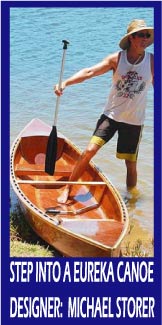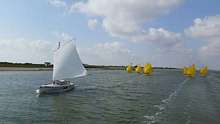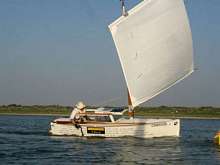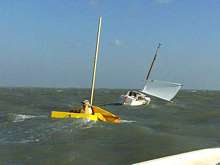
 Custom Search
|
| boat plans |
| canoe/kayak |
| electrical |
| epoxy/supplies |
| fasteners |
| gear |
| gift certificates |
| hardware |
| hatches/deckplates |
| media |
| paint/varnish |
| rope/line |
| rowing/sculling |
| sailmaking |
| sails |
| tools |
| join |
| home |
| indexes |
| classifieds |
| calendar |
| archives |
| about |
| links |
| Join Duckworks Get free newsletter CLICK HERE |
|
|
| Sailing Lessons - Texas 200 Style - Part Two |
by Sean Mulligan - Lake Havasu, Arizona - USA |
|
So what next? Well, the Texas 200 sounded like the next step in upping-the-anty. And, after a 1400 mile drive, and two sometimes exhausting, sometimes crazy, sometimes hair raising days on the South Texas water, here I was sailing on day 2 of 5 aground and slightly stressed out, watching the sun get lower and my buddies get smaller. What in the HELL was I thinking? About a second before I curled up into the fetal position on the floor of Scout, the radio came to life again. It was Chuck "the Duck" Leinweber. The founder of all this craziness that is the T200. "Scout, work you way back upwind to those two poles back there. That is a channel to the ICW. You'll have to get in that channel and work your way around the other side of this island. Then catch up to us on the ICW". Now I gotta tell you, that transmission brought on the oddest mix of emotions I have experienced maybe ever in my life. At the time they all seemed intense to the max, and totally rational. Looking back, I have to laugh at the whole situation. I am going to throw out that I was pretty tired and blame it on that. Maybe it was the perceived stress of the T-200? The unfamiliarity of the location?, conditions?, etc. Possibly thinking about some of the "horror stories" from previous 200's? Fatigue? I don't know, but for some reason I was uncharacteristically on the verge of "freaking the hell out" as I realized "those turkeys are gonna sneak across this shallow water and I am now alone to figure this out" as the sun drops. I was like, "What the hell just happened?" One minute I felt like I was herding cats with Scout, zooming around the ducks at will. Now, suddenly the cats were on the loose and disappearing over the horizon! I was pissed, anxious, nervous, irritated, feeling pretty alone, and felt an incredible sense of urgency to remedy the situation. Like RIGHT NOW. Truth be told, I was in 1 foot of 87 degree water. Scout had easily 6 days of provisions on her and I was truly in "need" for nothing other than to find a deeper channel, to get underway, navigate around an island, and catch up. It was no big deal, but it was. It's hard to explain and a little embarrassing. I guess my biggest worry was that we were sailing to a last minute destination change that I had not had time to layout my navigation to before we shoved off hurriedly. I agreed to go, based on the "I'll follow you" method of navigation. Something I NEVER do. EVER. I guess I can't say that anymore. I'm pretty self-reliant when it comes to that kinda stuff and usually do my homework ahead of time. Last minute changes are challenging when the time to plan is not there. When the decision was being made to extend our day 2 sail another 10-12 miles to this new destination from the original planned destination site, and to push the daylight envelope, I said to another first timer, "um, something tells me this is a bad idea as I don't know where I'm going". A vote was taken to add the distance (I didn't vote as I was "the new guy"). Then I jogged down the beach ignoring my little voice, jumped in Scout, pushed off and well, you know the rest of the story. Time seemed of the essence. I got out of the boat, something I HATE doing in "open water" when the wind is blowing. I always picture some weird circumstance happening and loosing my hold on the boat leaving me stranded on a mud bank miles from dry land as the boat blows away. With a death grip on the bowline I started "African Queening" it. And yes, African Queening is a verb in Texas. It's when you imitate Humphrey Bogart dragging the African Queen through water too shallow to sail in. About a hundred yards back upwind, I found a channel and with some difficulty and got underway again on a course 90 degrees to my previous one. I made it to the channel markers and then out to the Inter Coastal, turned right and it was game on. I could see "Those Duckers" way up ahead emerging out onto the ICW as well. They were probably one to two miles ahead and setting sail. Unfurling Scout's main fully in a freshening breeze, I felt her surge forward and I was pretty sure I could reel them in. I did, and all was right with the world again.
Such is the Texas 200. A constant roller coaster of challenges and emotions. Or at least that was my first timer experience. You could VERY easily sail from our departure point to the destination, follow the ICW and have no issues at all, but that is not truly what this event is about for me. I wanted the small boat, difficult shallow route challenge. I got it. I have already left out so many stories of broken boats, heavy winds, difficult navigation, shallow, no "ridiculously shallow" massive bodies of water, mud banks, oyster bars, etc etc etc. I left out that at the skipper's meeting prior to the start it is made abundantly clear: "When you sail out of Port Mansfield, you are on your own. There is no chase boat, no rescue crew and no shore crew. Put your own recovery plan in place in case you don't make it to the end". (Typically 15-20% don't.) I also left this out. No, there are no rescue crews. Yet whenever anyone needed help anyone that could, stepped up and did whatever they could. I left out that the skills exhibited in heavy air by sailors in the most diminutive of vessels were outstanding over and over again, truly awe inspiring in some cases. I left out that these "non-standard" rigged boats with all kinds of different hull shapes weathered everything from dead calm to winds measured at well over 30 knots and the seas associated with them on open waters. I left out that conversations around the camps often included technical discussions of things like how a sailor changed the relationship of the Center of Effort versus Center of Lateral Resistance of his boat by relocating and rebuilding a mast step or rebuilding a leeboard to another specification or how another sailor took the plans for a boat and lofted them 10% over to modify the entire boat to his particular needs. These guys understand sailing to a deeper level than most, and not only do they read it, they use that knowledge with their hands and tools and bring it to life. I left out the incredible winds of the South Texas coast, the incredibly warm water, the wildlife and the scenery. And I left out the camaraderie. I came into this not knowing many in the group, and the ones I did know were more acquaintances. I left with friends with whom I shared a true adventure. There were times during the trip that had a helicopter dropped out of the sky and offered me a way home, well lets just say, I would have been tempted, but I never allowed myself to quit. I was fatigued beyond that which I have been in years. I tested my little boat and was thrilled to see her perform beyond my expectations. I tested my own skills and found them adequate to pass the challenge. I learned a lot about myself and how to keep my emotions in check and stay focused on achieving the current goal. I learned not to eat the elephant whole, but to take one bite at a time. To sum it up. I shared this message to the Facebook Texas 200 page, it was a message to a sailing buddy I have who remarked about how "weird" the boats of the Texas 200 were. He's a good friend and meant no harm or disrespect at all with the comment. I tried to reword it for here, but I'm gonna just copy it over. It describes my take how the T-200 really was for me.
We arrived at our destination on day 2 as the sun was setting. I ran aground again near the entrance channel to the area we were going. It was difficult getting ungrounded and into where I wanted to be. Most of us made it, not everyone though. Night fell, everyone made their resting spot for the night. We had 3 more days and tons of adventures still ahead of us. I slept good. There is no such thing as insomnia on the T-200. Sailhavasu - sailhavasu.com
My blog - www.fullnby.com
My YouTube channel - www.youtube.com/user/nebwest2 |
To comment on Duckworks articles, please visit one of the following:
|
 |






